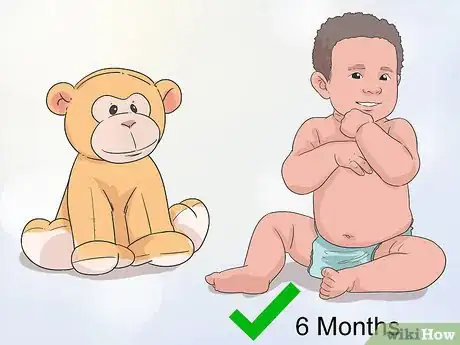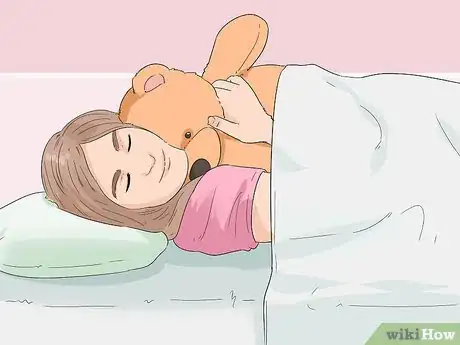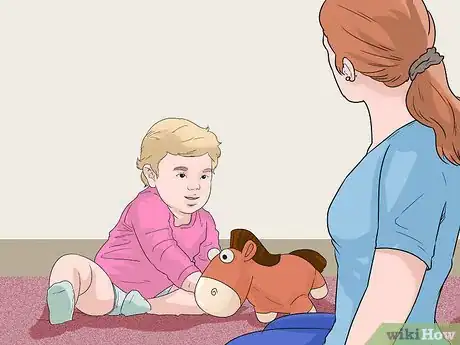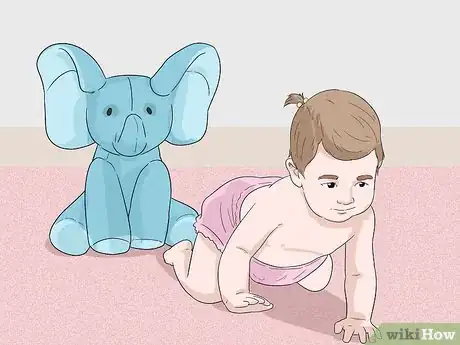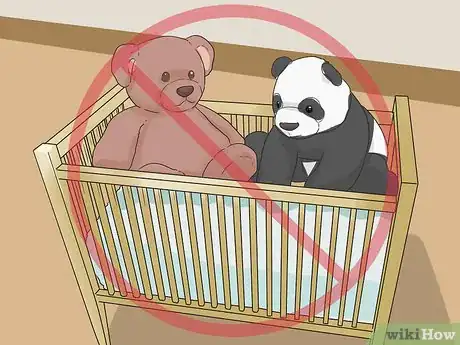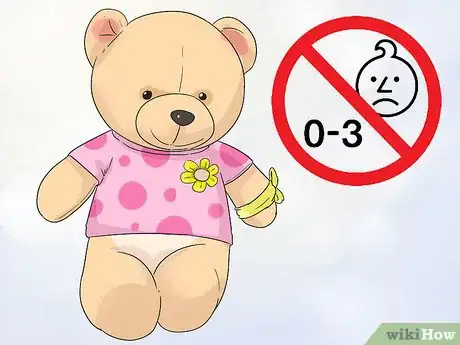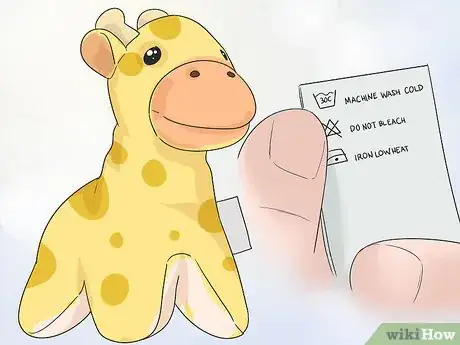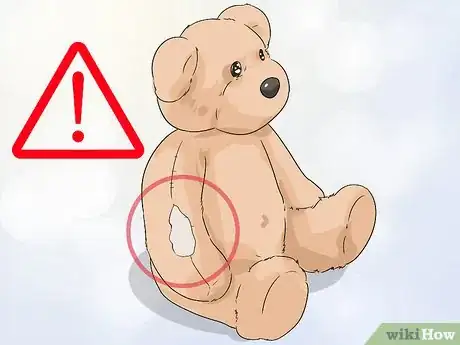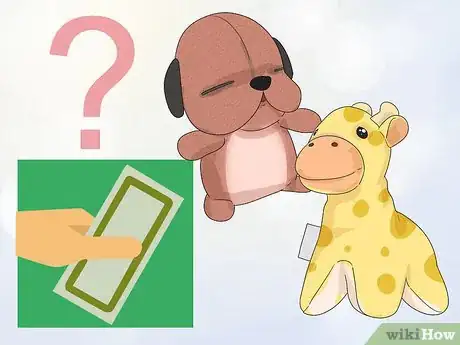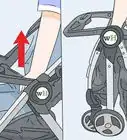This article was co-authored by Catherine Palomino, MS and by wikiHow staff writer, Jessica Gibson. Catherine Palomino is a former Childcare Center Director in New York. She received her MS in Elementary Education from CUNY Brooklyn College in 2010.
This article has been viewed 25,008 times.
You might have fond memories of a favorite childhood stuffed animal. If you'd like to introduce your baby to their very own stuffed animal, you'll need to choose one that's safe. Once you've selected a stuffed animal, lovey, or blanket, you can present it to your baby. To get your baby interested, engage with the baby and stuffed animal by snuggling or playing games. Remember, if your child doesn't seem interested, you can always try again later or offer another item.
Steps
Presenting the Stuffed Animal or Comfort Item
-
1Present the stuffed animal to your child around 6 months of age. This is when your baby is starting to really develop social skills and might form an attachment. You may notice your baby making more eye contact with people or becoming clingier. These are signs that your baby might like having their own stuffed animal or comfort item.[1]
- You might find that your baby has already chosen a favorite stuffed animal or comfort item at an early age, although it's rare for newborns to attach to an object.
-
2Keep the stuffed animal or lovey close to you. To help your baby accept the stuffed animal or attach to the comfort item, consider keeping it close to you before you offer it. This way, it will smell like you, which will comfort your baby. To impart your scent on the stuffed animal or comfort item, you can:[2]
- Sleep with it the night before you give it to your baby
- Keep it next to you as you snuggle with your baby
- Hold it against you while you nurse or feed your baby
Advertisement -
3Engage with your baby and their stuffed animal. Offer the stuffed animal to your baby and give them a chance to check it out. If your child seems disinterested in it, play peekaboo with it or talk to the stuffed animal. Your baby might become curious about the stuffed animal and begin showing an interest.[3]
- You could also snuggle with the stuffed animal and your baby when you read together or just cuddle.
- If you involve the stuffed animal in the baby’s routine on a regular basis, it will help them develop an interest and attachment to it.
-
4Follow your baby's lead. Your baby might love the new comfort item. But if your baby doesn't show much interest, don't force them to connect. Some babies want a comfort item or stuffed animal while other babies don't pay them much attention. Just let your baby decide what they want. They may end up choosing a different stuffed animal or might wait a few months before becoming attached to one.[4]
- Some babies that self-soothe might not want a comfort item or stuffed animal. These babies may prefer rubbing their hands through their hair or sucking a thumb or pacifier.
- Make sure that other parents and caregivers are on the same page. If your child goes to daycare, make sure that the daycare will provide the stuffed animal for your baby as consistently as you do.
-
5Avoid putting stuffed animals in your baby's crib. Practice safe sleep habits by waiting until your baby is at least 12 months old before leaving stuffed animals in their crib. You should also avoid letting them sleep with any soft loveys, blankets, or bumpers, since these could increase the risk of Sudden Infant Death Syndrome (SIDS), suffocation, or strangulation.[5]
- Don't forget to remove any pillows or soft crib bumpers as well. Wait to introduce pillows until your baby is at least 2 years old.
Choosing a Safe Stuffed Animal or Comfort Item
-
1Look for stuffed animals filled with cotton or acrylic. Parents and caregivers have more choices than ever when it comes to stuffed animals. Select a high-quality stuffed animal, since it may be with your baby for years. You should pick one that's filled with cotton or acrylic batting (stuffing) because these won't be hazardous if the stuffed animal tears.[6]
- Avoid stuffed animals filled with beans or plastic beads. These could be choking hazards if they spill out through a hole or tear.
-
2Choose stuffed animals or loveys that aren't choking hazards. Look over the stuffed animal or comfort item to ensure there's nothing that could come loose and become a choking hazard. For example, avoid stuffed animals with small buttons that could be pulled off, ribbons, or small plastic parts.[7]
- You should also choose a stuffed animal or comfort item that's small. This will make it easier for your growing baby to eventually toddle around with it.
-
3Consider how you'll clean the stuffed animal or lovey. Read the care information for the stuffed animal or lovey before you buy it. If it looks like it can't be simply cleaned or washed at home, you may want to choose something else. If your child attaches to it, you'll need to wash it occasionally. When in doubt, you can put the item inside a pillowcase and tie it shut. Toss it in a gentle wash cycle and tumble dry it on low.[8]
- Putting the item in the pillow case will prevent it from being thrown about too much as it washes and dries.
-
4Regularly check the stuffed animal for signs of wear. If your baby attaches to a stuffed animal or lovey, the item might become worn. In addition to washing it frequently, you'll need to check it every few weeks for any needed repairs or safety concerns. Mend the stuffed animal before you give it back to your child.
- For example, you may see holes forming and stuffing falling out. You can sew the stuffed animal shut or take it to someone who can mend it for you.
- If the item is too worn to repair and is hazardous to your baby, you'll need to replace it.
-
5Think about buying multiple stuffed animals or comfort items. Once your child has attached to a stuffed animal or lovey, you may want to go back to the store and purchase more of them. Having more than one of the same stuffed animal or item can come in handy if you ever lose it or it simply wears out.[9]
- Keep in mind that some small children won't accept a replacement, even if it is the same stuffed animal (just newer). Your child might want to attach to something else.
References
- ↑ http://www.whattoexpect.com/playroom/playtime-tips/babies-and-stuffed-animals.aspx
- ↑ http://sleeplady.com/baby-sleep/why-your-baby-needs-a-transitional-object/
- ↑ http://www.whattoexpect.com/playroom/playtime-tips/babies-and-stuffed-animals.aspx
- ↑ http://www.babysleepsite.com/sleep-training/baby-lovey-how-when-why/
- ↑ http://www.babycenter.com/404_when-can-my-baby-sleep-with-a-stuffed-animal-or-doll_1368443.bc
- ↑ http://www.parents.com/baby/development/separation-anxiety/babys-transitional-object/
- ↑ http://sleeplady.com/baby-sleep/why-your-baby-needs-a-transitional-object/
- ↑ http://sleeplady.com/baby-sleep/why-your-baby-needs-a-transitional-object/
- ↑ http://www.gq.com/story/how-to-find-proper-stuffed-animal
